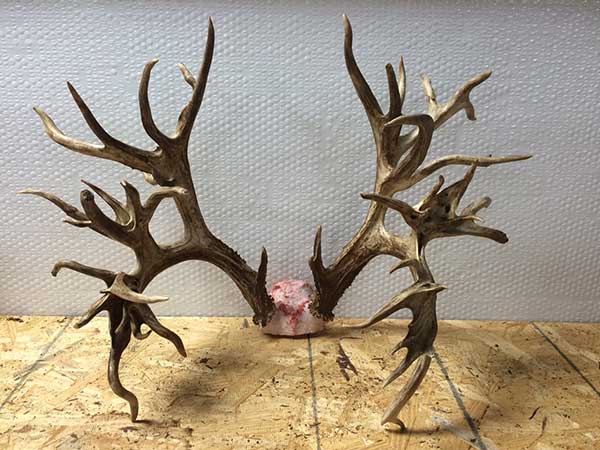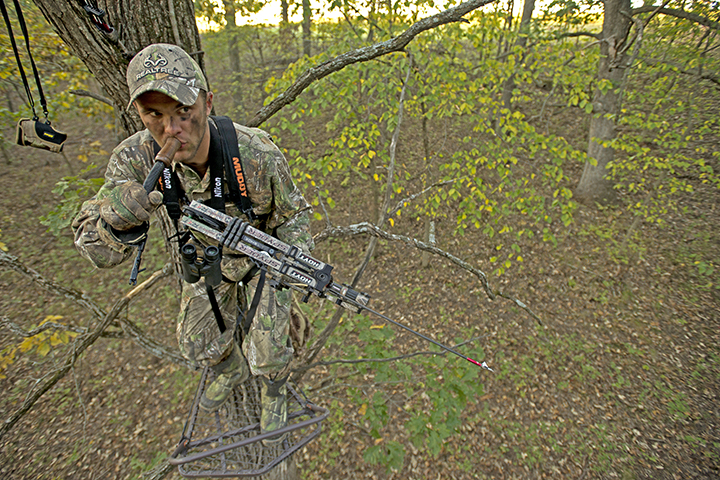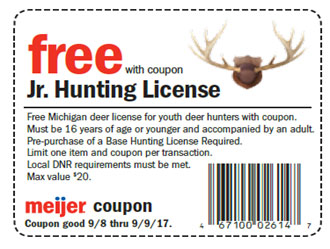- Details
By John L. Sloan
(Editor’s note: John Sloan’s writing takes a no-nonsense, straightforward, informative -- and highly entertaining -- approach to hunting. His hunting articles are archived at www.targetcommbooks.com, along with other hunting how-to articles taken from the “On Target” series published by Target Communications Outdoor Books.)
 Massive Rack
Massive Rack
This rack is from the pending new world record, non-typical whitetail buck killed in Tennessee in November, 2016, during the muzzleloader season. Yes, it is a trophy. But it also is an anomaly. In the wild, you cannot manage to grow deer like this. Once in a while it just happens.
The term “trophy buck” has been around about as long as black powder. Or maybe a lot longer; like, since big antlers have been found in prehistoric campsites.
So what is a trophy deer, really? Without question, it can be a deer of many characteristics or even of either sex. Sure, there are trophy does. Ask any kid whose first deer is a fat doe. You think that isn’t a trophy to that kid?
But what do veteran hunters call a trophy. To most, it is probably a deer with antlers that score over a certain minimum. Three major scoring groups -- Pope and Young Club for archery, Boone and Crocket for deer taken with any equipment that score over a higher minimum, and the Safari Club International for African or exotic game. All have different minimum scores.
What do we mean by ‘scores?’
Score is basically the number of inches a buck’s rack totals – length of each point on each antler beam, circumference of antlers between points on each antler beam, and inches of inside spread between antler beams. All are totaled and then the difference in measurement between left and right beams and point totals is subtracted to get a net score. The minimum typical, net score for P&Y is 125 inches; for Boone and Crockett, it is 160.
So...what? Is that what a trophy is?
Is a trophy nothing more than a bunch of numbers? For some hunters, yes. For others, a trophy is in the age of the animal, not the antlers. If you subscribe to the thinking that the older a buck gets, the more difficult it is to kill, then yes, age is the measure of a trophy.
How about the smart old Madame Doe? Put as much pressure on a doe as on a big-antlered buck and she becomes every bit as hard to kill as an old buck. Maybe harder.
- Details
MDNR Report
With the firearm deer season complete, the Michigan DNR has now identified a total of 30 free-ranging white-tailed deer that are confirmed or suspected to have chronic wasting disease. Several thousand additional samples are awaiting testing by Michigan State University, so numbers for this deer season could still change.
Since May 2015 when the first CWD deer was found, the DNR has tested approximately 23,000 deer. Of those tested, 30 cases of CWD have been suspected or confirmed in deer from Clinton, Ingham, Kent and Montcalm counties. CWD suspect means that the deer tested positive on an initial screening test, but has not yet been confirmed through additional testing. It is very rare that a CWD suspect will not be confirmed as a CWD-positive animal, but it is possible.
From 2015 to 2016, a total of four deer (in DeWitt, Eagle and Watertown townships) in Clinton County tested positive. So far in 2017, a single CWD suspect has been identified in Westphalia Township, also in Clinton County. In Ingham County, five deer from Meridian Township tested positive from 2015 to 2016; since then, no deer from Ingham County have tested positive for CWD.
In Montcalm County, a total of 17 deer from the following townships are suspected or confirmed to be positive for CWD: Cato, Douglass, Fairplain, Maple Valley, Montcalm, Pine, Reynolds, Sidney and Winfield. In Kent County, three CWD-positive deer were found in Nelson and Spencer townships. This is the first year any CWD-suspect free-ranging deer were found in Montcalm or Kent counties.
- Details
By Gary Sefton
(Editor’s note: Gary Sefton is an expert caller of deer and turkeys and who has won the World Deer Calling Championship and has conducted far more than 1,000 deer calling seminars throughout the U.S. This story is excerpted from his book “CALLING WHITETAILS / Methods, Myths & Magic,” a no-nonsense, back-to-basics guide to calling deer, and other deceptions to help. Chapters include whitetail deer practical vocabulary, deer calling basics (why deer respond to calls), calling during the rut (mating anticipation), antler rattling, other deceptions (scents, blinds, decoys), tips to increase your calling success, be familiar with your calls, and have a plan. The book is available at www.targetcommbooks.com.)
 Tips to Increase Your Deer Calling Success
Tips to Increase Your Deer Calling Success
I can’t begin to tell you how many tales of woe I’ve heard from seasoned deer hunters who missed out on golden opportunities because their brains were on pause when a buck showed up.
If you believe in something like a deer call enough to buy it and haul it to the woods with you, then you should believe something is going to happen when you use it. You want the deer to come into the area to investigate the deer making the call. He may come in hard and fast or he may slip in and be gone before you know he was there.
Make the call and then wait for him! Look for him! Stay on ‘red alert’ for 15 to 20 minutes after you make the call. Expect a response and anticipate success. You will still get caught with your guard down from time to time, but you won’t feel so dumb about it.
- Details
MDNR Report
A 3 -year-old female deer taken during Michigan's youth deer hunting season is likely to be the 10th free-ranging deer in the state found to have chronic wasting disease.
The animal was harvested in Montcalm Township in Montcalm County, and preliminary tests indicate the animal may be positive for CWD. The DNR is awaiting final confirmation from the Michigan State University Veterinary Diagnostic Laboratory.
Montcalm is located north of Grand Rapids. Since May 2015, the DNR has actively conducted surveillance for CWD. To date, more than 14,000 deer have been tested since the first positive case was found, with nine cases of CWD confirmed already in free-ranging white-tailed deer previously identified in Ingham and Clinton counties.
The suspect deer from Montcalm County was harvested by a youth hunter during the September youth season. The hunter voluntarily took the animal to a DNR deer check station and submitted the animal for testing.
"We cannot thank this family enough for bringing their deer to a check station, said Dr. Kelly Straka," DNR state wildlife veterinarian. "Without their effort, the disease may have gone undetected in this area. We encourage hunters from any part of the state, especially the south-central Lower Peninsula, to have their deer tested."
CWD is a fatal neurological disease that affects white-tailed deer, mule deer, elk and moose. It is caused by the transmission of infectious, self-multiplying proteins (prions) contained in saliva and other body fluids of infected animals. Susceptible animals can acquire CWD by direct exposure to these fluids, from environments contaminated with these fluids or the carcass of a diseased animal.
Some CWD-infected animals will display abnormal behaviors, progressive weight loss and physical debilitation; however, deer can be infected for many years without showing internal or external symptoms. There is no cure; once a deer is infected with CWD, it will die.
"Infected deer don't necessarily look sick," Straka said. "Having your deer tested is the only way to know if it has chronic wasting disease."
- Details
MDNR Report
 Free Junior Deer Hunting Licenses Available at Meijer Friday/SaturdayYoung hunters once again will have the opportunity to get a free deer hunting license at all Meijer stores in Michigan Friday and Saturday, Sept. 8-9.
Free Junior Deer Hunting Licenses Available at Meijer Friday/SaturdayYoung hunters once again will have the opportunity to get a free deer hunting license at all Meijer stores in Michigan Friday and Saturday, Sept. 8-9.
Youths must be accompanied by an adult, and can receive the free junior deer hunting license coupon in stores.
The coupon is valid for one junior deer hunting license, a $20 value, or mentored youth hunting license. Those who hunt in Michigan also must purchase a base license, which costs $6 for youth ages 10-16. The base license allows hunters to hunt small game and purchase additional hunting licenses. The mentored youth hunting license, valid only for hunters under the age of 10, includes a base license and does not require separate purchase of the base license.
Meijer has offered youth hunters free deer hunting licenses since 2008.




